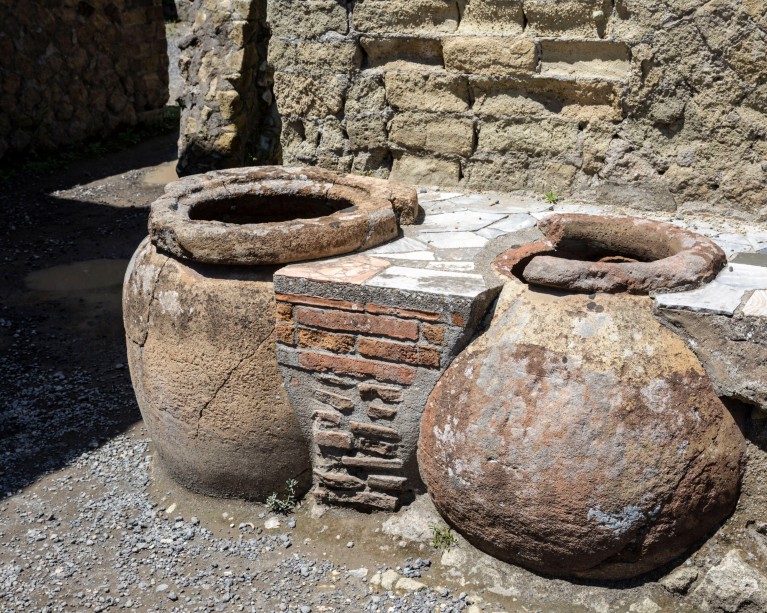
Two exposed food storage containers in the remains of a Roman food outlet, Herculaneum, Campania, Italy. Credit: John McKenna / Alamy Stock Photo.
In 79 CE, the eruption of Mount Vesuvius destroyed the Roman settlement of Herculaneum. Some of the population managed to escape, but many died trying. Hundreds of men, women and children sought refuge in boathouses along the shore, but a cloud of searing gas and ash instantly killed them all. In recent years, the excavations in the site turned up the remains of 340 individuals.
Now, an international research group has revealed in unprecedented detail the dietary habits of those individuals. Using chemical and physical analysis combined with statistical modelling, the group examined the bone collagen (a protein that holds bone tissue together) of 6 female and 11 male skeletons.
Some chemical elements occur in nature as mixes of different isotopes, i.e. atoms with same proton number but different masses, and the relative abundance of different isotopes in a molecule provides information about the origin of the element. Authors of the study reconstructed the diet of the ancient inhabitants of Herculaneum by measuring the isotopic ratios of collagen amino acids, that are mostly derived from dietary sources, and comparing them with major food groups.
“In the Mediterranean context we were the first to apply isotope analysis to single amino acids rather than the whole collagen, so we could discriminate between the consumption of cereals, animal products and fish”, says Silvia Soncin, PhD candidate at the Department of Archaeology, University of York, first author of the study in Science Advances1.
“We used a new statistical modelling which embeds prior knowledge about amino acids metabolism and information from the environment”, explains Luciano Fattore, PhD candidate at the Environmental Biology Department, Sapienza Università di Roma, co-author of the study. “The isotopic ratios of dietary groups we used as baseline data come from archaeological samples of food remains collected in the area”.
Bone collagen analysis revealed unexpected information about dietary pattern in ancient Herculaneum. Cereal consumption was lower and fish consumption was higher compared to the typical Mediterranean diet as defined in the 1960s. In addition, significant differences were observed between males and females: men ate more fish than women, who obtained more of their dietary proteins from terrestrial animal products, such as meat, eggs and dairy.
“The relatively low consumption of cereals may imply that the so called Mediterranean dietary model was adopted more recently than we thought”, notes Mattia Pietro Balbo, researcher at the Department of Historical Studies, Università di Torino, who was not involved in the study. “On the other hand, Herculaneum wasn't the typical first-century Roman settlement,” he adds. "It was a rich and densely urbanized coastal town, with different eating habits from the rest of the Empire”.
About the gender dietary gap, Balbo adds that fish was a luxury item, and it may be supposed that men had access to this because of their higher social status. “Or, maybe, those male skeletons once were fishermen, used to eat fish waste, while the women lived and worked within households, eating products from the land,” he says.
